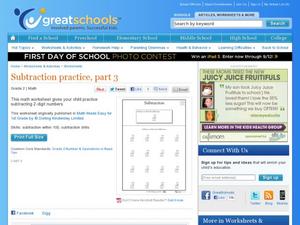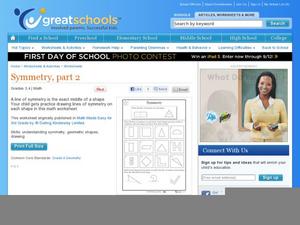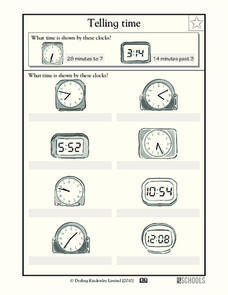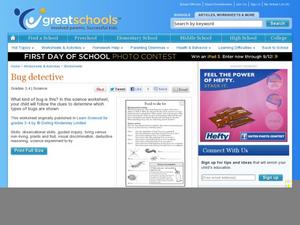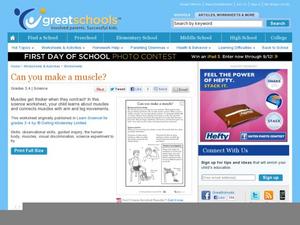Curated OER
Subtraction Practice, Part 3
A basic subtraction worksheet can help your second graders improve their problem-solving skills. Seventeen problems prompt learners to subtract two-digit numbers from two-digit numbers. None of the problems require carrying, so this...
Curated OER
Symmetry, Part 2
How can you tell if shapes are symmetrical? Fourth graders study 12 shapes, and draw lines down the middle of shapes that have symmetry. Once they are finished, they complete shapes that are missing their symmetrical sides. Some shapes...
DK Publishing
Taking 1 Away
Kindergartners who love animals will adore this sweet subtraction activity. They study pictures of birds, frogs, and ladybugs, and count how many are left if they take away one. Once they finish, they can color the animals and display...
Curated OER
Telling Time
Tick tock! Test your third graders' time skills by providing both analog and digital clocks for pupils to decipher. Most of the times are between five minute intervals, prompting your class to really interpret each stroke of the clock....
DK Publishing
Thin, Thinner, Thinnest
Reinforce comparative adjectives and relative size with a drawing activity. Kindergartners study a thin house and a thin balloon, then draw a thinner version of each. They also choose the thinnest bottle and lollipop in a group. Focus on...
Curated OER
Times Tables Practice Grids
Warm up your third graders' times table skills with a helpful learning exercise. With six grids detailing different times tables, this resource is sure to help even your struggling multiplication learners. Use it as a reference page once...
Curated OER
Understanding Place Value, Up to 3-Digit Numbers
Work on place value and addition. Here is a resource that features different types of problems for your second graders to solve. After studying the example at the top of the page, they write the missing number in 12 addition problems....
Curated OER
Understanding Place Value
Your fourth graders can write smaller numbers, but what about five-digit numbers? Practice writing expanded forms of large numbers with these activities. They work on place value skills, as well as written numbers. A great activity to...
Curated OER
Units of Measurement
Challenge your second graders with a worksheet on units of measurement! Not only do they put their measurement skills to the test, but kids practice word problem strategies as well. The second part of the resource prompts learners to...
Curated OER
What's Missing Here? - Necessary Information
Take your third graders' problem-solving skills to the next level. Six word problems need a solution, but they aren't solvable in their current forms. Learners explain the piece of missing information that they need to solve the word...
Curated OER
What's the Time? #2
Challenge your class's time-telling skills with fifteen analog clocks, all with blank faces. They write the hands in the correct places, all with times to the nearest five minutes. An easy way to extend this assignment would be a group...
DK Publishing
Which is Biggest?
Help kindergartners determine which picture is biggest, tallest, longest, and thinnest! After studying four sets of pictures, kids choose the picture that is indicated in the instructions. Color the page once they're done for extra fun!
DK Publishing
Write the Missing Numbers
Funny clowns and balloons help your preschoolers and kindergartners count! Each bunch of balloons is missing some numbers in its sequence. The numbers go up to 20, allowing youngsters to practice both counting and printing skills. Color...
DK Publishing
Writing Equivalent Number Sentences
Connect the four operations with a series of number sentences. After studying the examples at the top of the page, third graders find ways to write related number sentences for addition, subtraction, multiplication, and division...
Curated OER
Commas
Learning how to properly use the comma is an important writing skill. This worksheet, designed for first graders, gives them some coaching on the subject along with opportunities to practice. There are five sentences which must be...
Curated OER
Drawing Curvy Lines
Can your youngsters trace a curvy line? Have them guide their pencil over part of a loop, then finish the line on the right side of the page. They can fill the rest of the page with their own curvy lines. A great way to work on fine...
Dorling Kindersley
Punctuation Practice
Need some punctuation practice? Challenge your third or fourth graders' editing skills with a helpful instructional activity on punctuation. After naming different types of punctuation marks, they rewrite a paragraph that has multiple...
Curated OER
A Device That Condenses Water
Fifth graders who are studying water vapor and the condensation process use this worksheet to help them understand the process of condensation. Most of the worksheet is simply a source of information, with a good descriptive paragraph...
Curated OER
Be Kind to Mother Nature!
A clever worksheet on identifying things that harm the environment is here for you. Elementary schoolers read a short paragraph describing the harm that can come to the environment due to human activities. Then, they must circle five...
Curated OER
Bite on This!
Different types of teeth have different roles. Third graders study how molars, incisors, and canines function in a rabbit skull and a cat skull. After answering some questions about the teeth of herbivores and carnivores, kids...
Curated OER
Human Parts
Very young learners who are studying the human body will use this worksheet to identify certain body parts. A cartoon drawing of a boy is shown, and learners must draw lines matching up words such as arm, tummy, foot, and toes to the...
Curated OER
Bug Detective
What happens when a living thing dies? After reading a paragraph of background knowledge on the life cycle of bugs, third and fourth graders work through four clues to figure out which bug is which. When they finish, they can study the...
Curated OER
Building a House
Study the different materials needed to build a house. Kindergartners and first graders read five sentence frames, and match the phrases that describe wood planks, glass, and clay. An experiment prompts kids to test different types of...
Curated OER
Can You Make a Muscle?
Why are muscles important? Third graders study the different kinds and functions of muscles in the human body. After drawing arrows in an illustration to indicate where a muscle contraction would occur, they do their own experiment about...
Other popular searches
- Library Skills Lesson Plans
- Library Skills Elementary
- Smart Board Library Skills
- Teaching Library Skills
- Library Skills Quizzes
- Library Skills Videos
- Library Skills Grade 7
- Library Skills Plan
- Library Skills and Esl
- December Library Skills
- Research Skills Library
- Library Skills Book Choice


